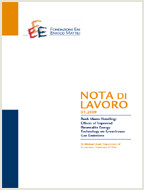Implications of the 2030 EU Resource Efficiency Target on Sustainable Development

Data
28.04.2015
28.04.2015
Autori
Lorenza Campagnolo (Fondazione Eni Enrico Mattei, Centro Euro-Mediterraneo sui Cambiamenti Climatici); Fabio Eboli (Fondazione Eni Enrico Mattei, Centro Euro-Mediterraneo sui Cambiamenti Climatici)
Codice JEL
C68, D58, L61, O13
C68, D58, L61, O13
Parole chiave:
Material Productivity, Resource Efficiency, Sustainable Development Indicators, Computable General Equilibrium
Material Productivity, Resource Efficiency, Sustainable Development Indicators, Computable General Equilibrium
Publisher
Climate Change and Sustainable Development
Climate Change and Sustainable Development
Editor
Carlo Carraro
Carlo Carraro
The paper explores the implications of achieving the EU27 Resource Efficiency target by 2030 for the future sustainability of the area. The target involves increasing by well over 30% within 2030 EU27 Resource Productivity, which would correspond to nearly double the annual growth rate of the pre-crisis period. The analysis uses a model-based index (FEEM Sustainability Index, FEEM SI) conceived to assess sustainability across time and countries. FEEM SI builds on the recursive-dynamic computable general equilibrium (CGE) model ICES-SI, which considers jointly variables belonging to the three sustainability dimensions (economy, society, and environment). The indicators produced in this framework are first normalized and then aggregated by using some elicited weights and a non-linear methodology. The 30% increase of EU27 Resource Efficiency by 2030 is achieved by applying an ad-valorem tax to the use of mining resources, and offsets the negative effects on the economy (slightly lower GDP and Investment rate) with considerable benefits for the environment. This implies a +1.02% increase in overall EU sustainability with respect to the reference “no policy” scenario.
***
Suggested citation: Campagnolo, L., F. Eboli, (2015), ‘Implications of the 2030 EU Resource Efficiency Target on Sustainable Development’, Nota di Lavoro 36.2015, Milan, Italy: Fondazione Eni Enrico Mattei
